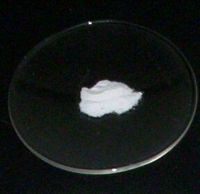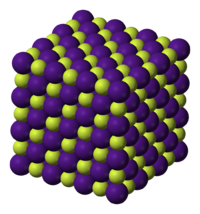Caesium fluoride
2008/9 Schools Wikipedia Selection. Related subjects: Chemical compounds
| Caesium fluoride | |
|---|---|
 |
|
 |
|
| IUPAC name | Caesium fluoride |
| Other names | Cesium fluoride |
| Identifiers | |
| CAS number | [13400-13-0] |
| RTECS number | FK9650000 |
| Properties | |
| Molecular formula | CsF |
| Molar mass | 151.904 g/mol |
| Appearance | white crystalline solid |
| Density | 4.115 g/cm³, solid |
| Melting point |
682 °C (955 K) |
| Boiling point |
1251 °C (1524 K) |
| Solubility in water | 367 g/100 ml (18 °C) |
| Structure | |
| Crystal structure | cubic |
| Coordination geometry |
Octahedral |
| Dipole moment | 7.9 D |
| Hazards | |
| MSDS | External MSDS |
| Main hazards | toxic, forms HF with acid |
| R-phrases | 23/24/25, 34 |
| S-phrases | 26, 36/37, 39, 45 |
| Related compounds | |
| Other anions | caesium chloride caesium bromide caesium iodide |
| Other cations | sodium fluoride potassium fluoride rubidium fluoride |
| Related compounds | tetra-n-butylammonium fluoride |
| Except where noted otherwise, data are given for materials in their standard state (at 25 °C, 100 kPa) Infobox disclaimer and references |
|
Caesium fluoride (cesium fluoride in North America), is an ionic compound usually found as a hygroscopic white solid. It is more soluble and more readily dissociated than sodium fluoride or potassium fluoride. It is available in anhydrous form, and if water has been absorbed it is easy to dry by heating at 100 ° C for two hours in vacuo. It is therefore a useful, less hygroscopic alternative to tetra-n-butylammonium fluoride (TBAF) and TAS-fluoride (TASF) when anhydrous "naked" fluoride ion is needed. Like all soluble fluorides, it is mildly basic. Contact with acid should be avoided, as this forms highly toxic/corrosive hydrofluoric acid.
Chemical properties
Caesium fluoride reacts usually as a source of fluoride ion, F-. It therefore undergoes all of the usual reactions associated with soluble fluorides such as potassium fluoride, for example:
2 CsF ( aq) + CaCl2 (aq) → 2 CsCl (aq) + CaF2 ( s)
Being highly dissociated it is quite reactive as a fluoride source under anhydrous conditions too, and it will react with electron-deficient aryl chlorides to form aryl fluorides ( halex reaction). Due to the strength of the Si–F bond, fluoride ion is useful for desilylation reactions (removal of Si groups) in organic chemistry; caesium fluoride is an excellent source of anhydrous fluoride for such reactions (vida infra). As with other soluble fluorides, CsF is moderately basic, because HF is a weak acid. The low nucleophilicity of fluoride means it can be a useful base in organic chemistry.
Crystal structure
Caesium fluoride has the inverse halite structure, because caesium ions are larger than fluoride ions; in the lithium, sodium, potassium, and rubidium halides, the cation is smaller than the anion. The caesium ions form a cubic closest packed array with fluoride ions in the octahedral holes.
Preparation
Caesium fluoride may be prepared by the action of hydrofluoric acid on caesium hydroxide or caesium carbonate, followed by removal of water.
Uses
Caesium fluoride is a useful base in organic chemistry, due the fact that fluoride ion is largely unreactive as a nucleophile. It is reported that CsF gives higher yields in Knoevenagel condensation reactions than KF or NaF.
Removal of silicon groups (desilylation) is a major application for CsF in the laboratory, as its anhydrous nature allows clean formation of water-sensitive intermediates. Caesium fluoride in THF or DMF can attack a wide variety of organosilicon compounds to produce an organosilicon fluoride and a carbanion, which can then react with electrophiles, for example:
Desilylation is also useful for the removal of silyl protecting groups.
Caesium fluoride is also a popular source of fluoride in organofluorine chemistry. For example, CsF reacts with hexafluoroacetone to form a caesium perfluoroalkoxide salt which is stable up to 60 °C, unlike the corresponding sodium or potassium salt.
Single crystals of the salt are transparent into the deep infrared. For this reason it is often used as the windows of cells used for infrared spectroscopy.
Precautions
Like other soluble fluorides, CsF is moderately toxic. Contact with acid should be avoided, as this forms highly toxic/corrosive hydrofluoric acid. Cesium ion (Cs+), or Cesium chloride, is generally not considered toxic.
